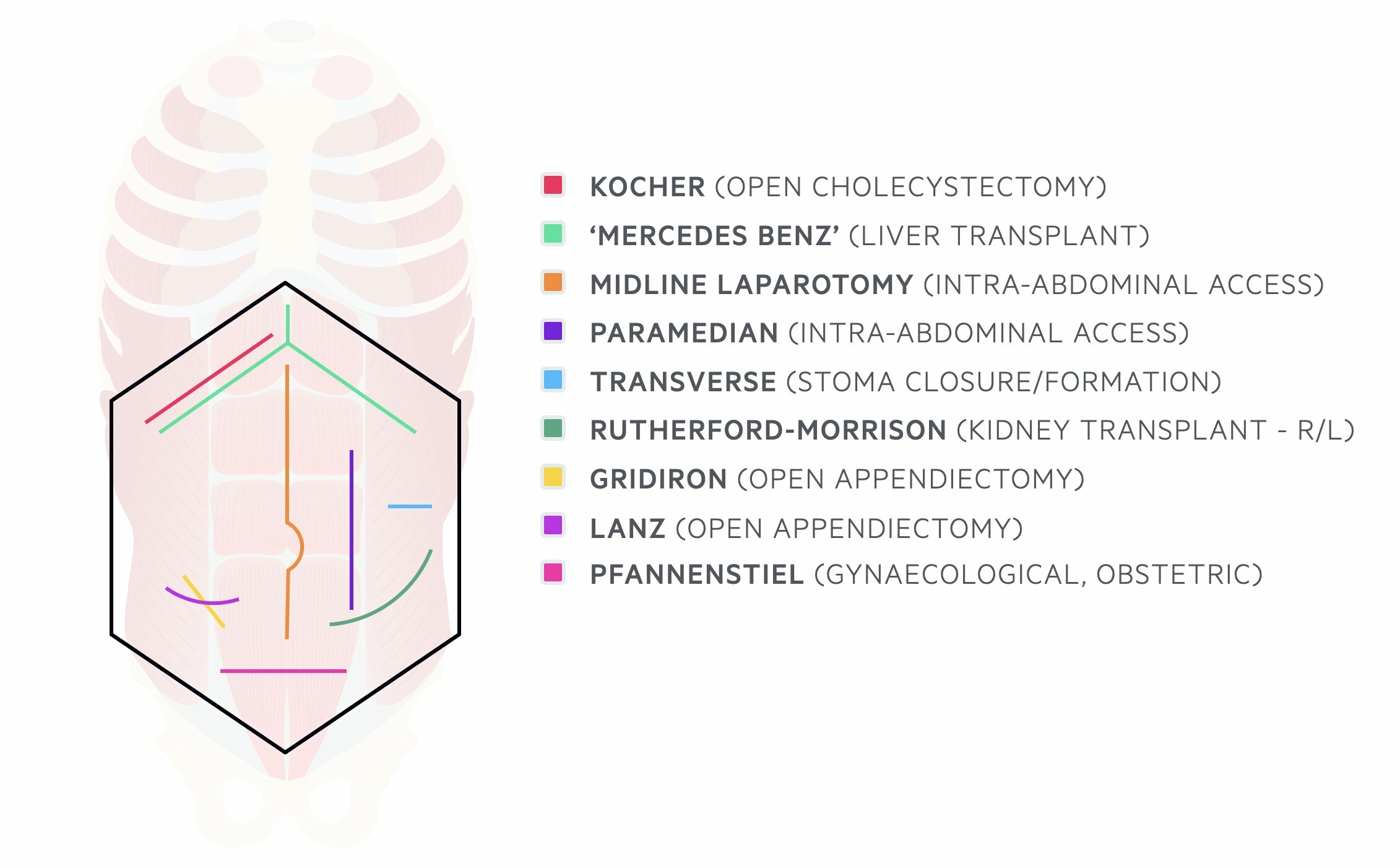Abdominal incisions
Notes
Overview
A surgical incision refers to a cut made through the skin to access deeper tissue or facilitate an operation.
An abdominal incision refers to a surgical cut made anywhere on the abdomen. This enables access to deeper tissue to facilitate an operation by gaining access to the intra-abdominal or intra-pelvic cavities. There are a number of characteristic incisions that are completed on the abdomen to facilitate open surgery. Many of these have eponymous names.
Knowledge of abdominal incisions is important for exams.

Kocher
This is a subcostal incision that is completed to gain access to the upper abdomen.
A Kocher (subcostal) incision is commonly performed in the right upper quadrant for open cholecystectomy. The skin incision is placed approximately 3 cm below and parallel to the costal margin.
Chevron
A chevron incision is more commonly known as a 'rooftop' incision.
A Chevron incision is essentially an extension of the Kocher incision across the midline to involve the other side of the abdomen. It is important for gaining good access to the upper abdomen for major surgery (e.g. liver transplantation, duodenal surgery, adrenalectomy).
The rooftop incision may be combined with a sternotomy incision during cardiac or liver surgery. This combined incision is known as a 'Mercedes-Benz' incision.
Laparotomy
A midline laparotomy incision involves a longitudinal cut in the middle of the abdomen.
A laparotomy is a very common surgical incision to gain access into the intra-abdominal cavity. It is often performed in an emergency (e.g. trauma) as it provides the most rapid entry into the abdomen. It may be a full incision from the xiphoid process to pubic symphysis or limited to the upper or lower abdomen by halting the incision at the umbilicus.
A laparotomy incision provides excellent exposure into the abdomen and provides excellent access to many organs including abdominal viscera, liver, spleen, major vessels (inferior vena cave, aorta), kidneys, and pelvic organs.
Variations of this longitudinal incision may be performed, which include:
- Paramedian incision: cut 2-5 cm left or right of the midline
- Pararectus incision: cut at the lateral border of the rectus muscle
NOTE: these incisions are less commonly performed as they take longer to complete and risk injury to surrounding structures (e.g. epigastric vessels, nerves)
Transverse
Several transverse incisions may be made across the abdomen for both abdominal and pelvic surgery.
Transverse incisions will usually follow the natural skin tension lines leading to a better cosmetic result during closure. A variety of incisions can be made to perform both abdominal and pelvic surgery. They may be performed above or below the umbilicus.
The Pfannenstiel incision is an example of a commonly employed transverse incision for gynaecological and obstetric procedures that is discussed below. Small transverse incisions may be used to form/close stomas or to extract laparoscopic resection specimens.
Rutherford-Morrison
The Rutherford-Morrison is an extension of the gridiron incision that is commonly performed for transplant surgery.
The Rutherford-Morrison incision is commonly completed for renal transplants. It may be used on the left or right-hand side.
The incision begins ~2 cm above the anterior superior iliac spine (ASIS) and extends obliquely down and medially through the skin and deeper tissue cutting them along the line of the skin incision.
A shorter version of this incision that is centred over McBurney's point (two thirds from the umbilicus to the ASIS) is known as the Gridiron incision that is used in conventional open appendicectomy. Extension of the Gridiron laterally and medially leads to a Rutherford-Morrison incision that is more colloquially known as a 'Hockey-stick' incision.
Pfannenstiel
The Pfannenstiel incision is a commonly used transverse incision to perform pelvic surgery.
Pfannenstiel's incision refers to a low transverse incision (10-15 cm) that is 2-5 cm above the pubic symphysis. It provides excellent access into the intra-pelvic cavity.
Lanz
A Lanz incision is a commonly performed abdominal incision for open appendicectomy.
The Lanz incision is an oblique incision made along Langer's lines. It is also known as the Rockey-Davis incision and it is essentially a modification of the traditional Gridiron incision (also known as McBurney's incision).
It is a transverse incision centred over McBurney's point (two-thirds from the umbilicus to the ASIS). The incision extends medially to the lateral border of the rectus abdominis and laterally the same distance. It is commonly completed or open appendicectomy and is considered to have a better cosmetic result compared to the Gridiron incision.
Last updated: July 2022
Have comments about these notes? Leave us feedback
